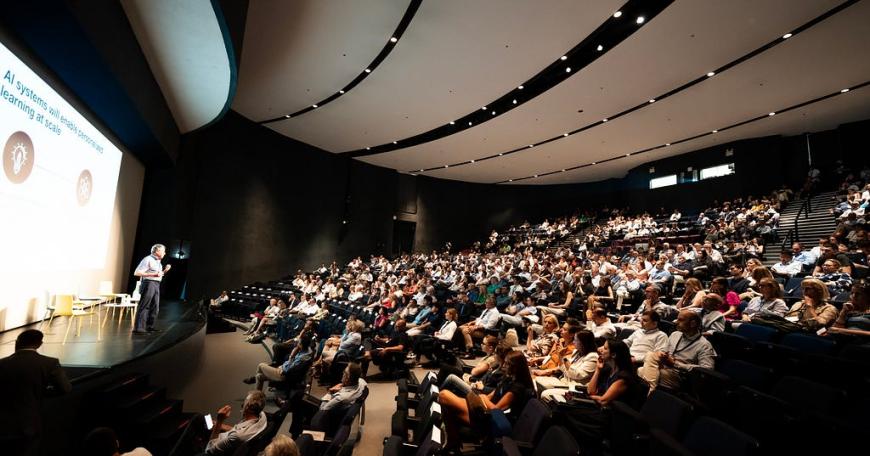
AI’s transformative potential for industry, academia, and government
By Carolyn Tiernan and Vassilis Papakonstantinou
Artificial intelligence is reshaping the way we learn, work, and govern, but how do we ensure AI education and opportunity is accessible to all? That question took center stage this summer when MIT Open Learning and StartSmart South Eastern Europe convened the inaugural MIT Universal AI Summit. Hosted in Athens, Greece, the summit examined transformative applications of AI across government, academia, and industry in the region, and previewed Open Learning’s in-development online learning experience, Universal AI. Throughout the day, four themes emerged:
1. Demystifying and seeing AI as a powerful tool for good
Several speakers grounded their remarks on the importance of a mindset shift when it comes to AI, and seeing it as an opportunity vs. an existential threat. Dimitris Bertsimas SM ’87, PhD ’88, vice provost for open learning at MIT, reminded the audience that the explosion of generative AI into the public conversation is a new phenomenon; other types of AI have been around for decades and used for public good. He emphasized that generative AI is here to stay, and it’s up to the educators, business leaders, and policymakers in attendance to shape how gen AI is used for good. On the education front, Open Learning is leading the way in how gen AI systems can be leveraged for personalized education with new features developed for the soon-to-be-launched Universal AI curriculum and the newly launched MIT Learn destination.
MIT Professor Manolis Kellis also presented a framework for understanding AI at the summit through the concept of “cognitive cartography.” Rather than seeing AI as a black box to fear, Kellis emphasized the power of “visual AI” — a method to literally see how AI processes data and generates answers, offering a visual map of AI’s reasoning. Central to this vision is Mantis, a dynamic workbench that allows users to interact with and explore high-dimensional data across domains like genomics, chemistry, and even social or philosophical content. Kellis argued that modern AI’s strength lies in deep representation learning, multimodal reasoning, and compositionality — the ability to form and manipulate meaning across diverse inputs.
2. Leveraging AI to supercharge entrepreneurship, business, and learning
Kathleen Kennedy, senior director of MIT Horizon at Open Learning, encouraged attendees to think of AI as more than just a productivity multiplier — when leveraged properly, it can elevate our thinking, improve decision making, and “supercharge” our work. She shared several case studies from Horizon’s work with corporate customers, including the U.S. Department of Defense, where the team used this approach to create custom learning solutions for employees to learn about and integrate AI systems and tools into their work. Other speakers shared their own examples of AI applications to uplevel existing work in academia, research, business, entrepreneurship, and more.
3. The importance of a product mindset for AI development
INSEAD Professor of Technology and Business Theodoros Evgeniou ’95, SM ’96, PhD ’00 brought a product development lens to the summit. He cautioned that the winners of the AI revolution will be those that can create a successful product leveraging the technology, not necessarily those investing the most in research. He pointed to the history of chemical engineering as precedent. Germany was the leader in chemical engineering research for much of the 19th century, but when it came time to formalize education and develop industrial chemicals for the budding industrial revolution, the U.S. — aided by the world’s first four-year chemical engineering curriculum created by MIT — was ultimately the “winner.” Evgeniou drew a parallel to the state of the AI race today, with a closing call to action that Europe must get into the game soon.
4. The AI “space race” is not over for Europe
The message from speakers, panelists, and partners was clear: Europe still has time to lead in AI, but the clock is ticking. Greece’s Minister of Digital Governance and AI, Dimitris Papastergiou, underscored that Europe’s competitive advantage lies in trust, regulation, and responsible innovation, and that now is the time to act boldly. Across panels, speakers emphasized that Europe shouldn’t try to mimic Silicon Valley, but instead lean into its own strengths: deep domain expertise, strong public-private institutions, and a values-driven approach. Corporate and ecosystem leaders highlighted sectors such as health, energy, and manufacturing as areas where Europe can lead in applied AI, particularly when innovation is tied to regional needs. StartSmart Network–operated startup programs are already demonstrating how early-stage companies can bridge the gap between academic research and real-world adoption. The takeaway? While Europe may not be ahead in raw compute or foundation models, it can shape the future of AI through smart adoption, focused innovation, and strategic collaboration.
Continuing the conversation and momentum
The MIT Universal AI Summit not only showcased the transformative power of AI across diverse fields but also highlighted how initiatives like Open Learning’s Universal AI are being designed to equip learners and organizations with AI knowledge innovation, entrepreneurship, and societal advancement. These discussions will continue at the next MIT Universal AI Summit, co-hosted by MIT Open Learning and StartSmart Central Eastern Europe in March 2026 and by StartSmart South Eastern Europe early next Summer.
Explore more session highlights and watch full recordings from the event on the StartSmart South Eastern Europe Substack page.
AI’s transformative potential for industry, academia, and government was originally published in MIT Open Learning on Medium, where people are continuing the conversation by highlighting and responding to this story.

